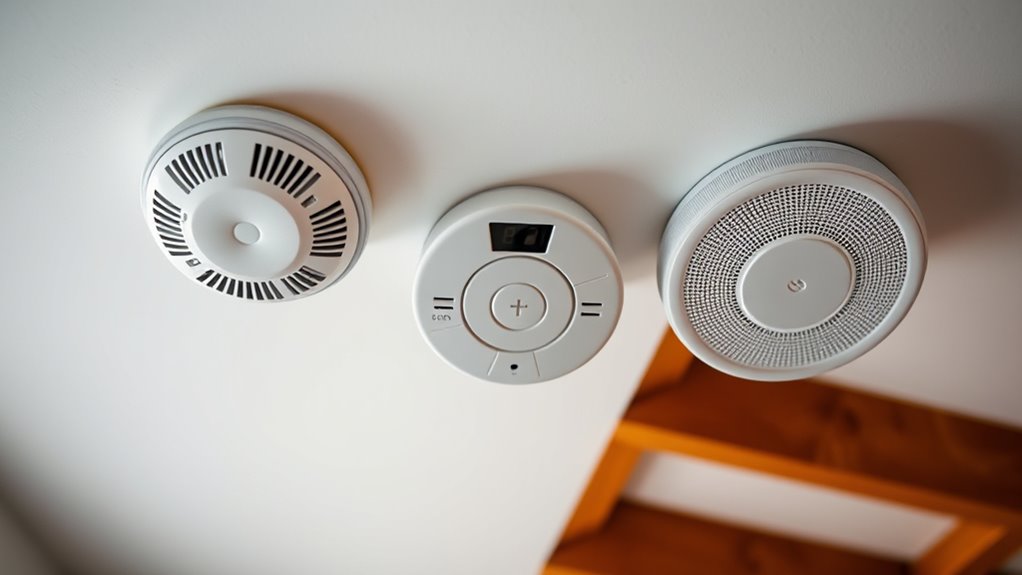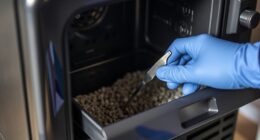For ideal safety, install smoke, CO, and heat alarms on every home level, especially outside sleeping and main living areas. Mount smoke alarms on the ceiling or high on the wall, keeping them at least 10 feet from kitchens and bathrooms to prevent false alarms. Place CO detectors at least 15 feet from fuel-burning appliances. Regularly test and clean your alarms to verify they work well, and following placement tips can improve their effectiveness—learn more to maximize your safety.
Key Takeaways
- Install smoke alarms inside bedrooms, outside sleeping areas, and on every home level, mounting on the ceiling or wall per guidelines.
- Place CO alarms at least 15 feet from fuel-burning appliances and avoid installing near vents, fans, or high humidity areas.
- Mount heat alarms in locations prone to rapid temperature changes, such as garages or boiler rooms, away from direct sunlight.
- Keep detectors at least 10 feet away from kitchens and bathrooms to reduce false alarms from steam and cooking fumes.
- Regularly test, clean, and maintain all alarms, and ensure proper placement to optimize early detection and reliability.

Choosing the right locations for detector placement is crucial to guarantee maximum coverage and effectiveness. When you install smoke, carbon monoxide (CO), and heat alarms, proper placement ensures you get early warnings and can respond quickly to dangers. One key aspect is alarm maintenance; regular testing and battery checks keep your detectors functioning correctly, but where you install them plays an equally important role in their performance. Confirming placement safety also means avoiding areas where detectors could be obstructed or damaged, which might compromise their ability to detect hazards promptly.
Start by installing smoke alarms on every level of your home, especially outside sleeping areas and in the main living spaces. Mounting them on the ceiling is ideal because smoke rises, making ceiling placement more effective. If ceiling mounting isn’t possible, install alarms on the wall about 4 to 12 inches below the ceiling. Keep detectors at least 10 feet away from kitchens or bathrooms to prevent false alarms caused by cooking fumes or steam. Positioning alarms thoughtfully reduces nuisance alarms and ensures reliable detection. When contemplating alarm maintenance, regularly vacuum or wipe the units to remove dust and debris, which can interfere with sensor sensitivity. Additionally, considering the placement guidelines can help optimize detector positioning for various home layouts and environments.
Install smoke alarms on every level, near sleeping areas, and in living spaces; mount on ceiling or 4-12 inches below, and keep clear of kitchens.
Placement safety involves avoiding locations where alarms could be accidentally disabled or disturbed, such as near windows with drafts or areas with high humidity. Keep alarms away from vents, fans, or air ducts that might blow smoke or gases away from the detector or dilute their concentration, delaying warning time. CO alarms should be installed at least 15 feet away from fuel-burning appliances to prevent false alarms from normal operation. Heat alarms require placement in areas prone to rapid temperature changes, like garages or boiler rooms, but not in spots with direct sunlight, which can cause false readings. Additionally, consulting alarm placement guidelines can help ensure optimal positioning in your home. Proper placement also involves considering the sensor sensitivity, ensuring alarms are neither too close nor too far from potential hazards.
A well-planned placement strategy can also help prevent false alarms caused by environmental factors and air circulation, which may affect detector performance. Safety should be your top priority; avoid installing detectors in cramped, inaccessible spaces or where they might be obstructed by furniture or curtains. Proper placement not only enhances alarm performance but also promotes consistent alarm maintenance, prolonging the life of your detectors and ensuring they work when you need them most. By paying close attention to placement safety and maintaining your alarms regularly, you can greatly improve your home’s safety and reduce the risk of dangerous emergencies going unnoticed.
Frequently Asked Questions
How Often Should I Replace the Batteries in My Alarms?
You should replace the batteries in your alarms at least once a year to maintain proper battery maintenance. Many alarms have a low-battery warning, so pay attention to that. Additionally, check the alarm lifespan, which is typically around 8-10 years, and replace the entire unit when it reaches that age. Regularly testing your alarms ensures they’re working correctly and keeps your home safe.
Can Different Brands of Alarms Be Interconnected?
Yes, different brands of alarms can be interconnected if they meet the same interconnection standards and are compatible. You should check each alarm’s specifications to guarantee they support the same interconnection protocol, like wireless or hardwired systems. When alarms are compatible, they can trigger simultaneously for added safety. Always follow manufacturer instructions to ensure proper installation and interconnection, giving you peace of mind knowing your alarms work together effectively.
Are There Alarms Suitable for Outdoor Use?
Did you know that outdoor alarms with weather resistance are essential for safety? Yes, there are alarms designed specifically for outdoor use that feature outdoor weather resistance and UV protection. These alarms withstand rain, snow, and sun exposure, ensuring reliable detection. You should look for models labeled for outdoor use, as they’re built to handle harsh conditions and keep your family safe, no matter the weather.
How Do I Test My Alarms for Proper Functioning?
You should test your alarms regularly to make certain they work properly. Use the testing button on each alarm to follow the testing procedures, which typically involve pressing and holding the button until the alarm sounds. During testing, check the alarm sensitivity by verifying it detects smoke, CO, or heat properly. If it doesn’t respond, replace the batteries or the entire unit to keep your home safe.
What Should I Do if Alarms Frequently False Alarm?
When your alarms go off like a fire drill every day, it’s time for alarm maintenance and false alarm prevention. Check for dust, insects, or steam that might trigger false alarms; clean the detectors gently. Test the alarms regularly, and replace batteries if needed. Consider upgrading to newer models if false alarms persist. Proper maintenance keeps your alarms reliable and prevents unnecessary panic—think of it as giving your safety system a well-deserved tune-up.
Conclusion
So, after all this careful planning, you might think placing detectors perfectly guarantees safety. Ironically, even the best-laid plans can’t prevent every fire or carbon monoxide leak. Your smoke, CO, and heat alarms are essential, but they’re only as good as where you put them—and sometimes, even that’s not enough. In the end, it’s your vigilance that truly keeps you safe, proving that technology can’t replace a cautious eye and quick action.










